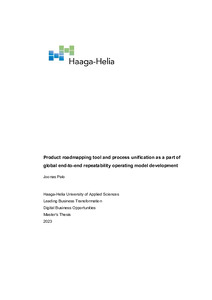Product roadmapping tool and process unification as a part of global end-to-end repeatability operating model development
Palo, Joonas (2023)
Palo, Joonas
2023
All rights reserved. This publication is copyrighted. You may download, display and print it for Your own personal use. Commercial use is prohibited.
Julkaisun pysyvä osoite on
https://urn.fi/URN:NBN:fi:amk-2023053016244
https://urn.fi/URN:NBN:fi:amk-2023053016244
Tiivistelmä
The purpose of this Master’s thesis was to describe best practices the case company’s product management and other relevant stakeholders should consider using when building a unified product roadmap tool and process.
The theoretical part of this thesis consists of elements of product management as a process, product strategy, and business process development. The theoretical framework was formed using key aspects within these categories in connection to building strong business and product strategies and how those are linked to product roadmapping.
Data was collected using thematic interviews. Product managers of the case company were interviewed in April 2023. Altogether the number of interviews was five. The research data was analysed by the content.
Five main dimensions relevant to the implementation of a unified tool and process for roadmap-ping were: (1) Creating a robust but agile collaboration tool, (2) Current ways of working com-pared to strategic targets, (3) Building a bridge between technical and business roadmaps, (4) Cooperation between key stakeholders and (5) Ownership of the product roadmaps.
The conclusions and key findings of the research showed that the case company roadmapping tools and processes are highly dependable on manual work which is not in line with the company's strategic targets of the end-to-end repeatability operating model. There is a lack of a unified way and standard for how the case company’s roadmaps should be built, maintained, or re-viewed. To succeed in the implementation of the new tool and process, the case company needs to identify key dependencies between different products and stakeholders. Also, the case company needs to establish a proper ownership structure to follow up on how the tool is taken into use, how it’s being used, and how it should be developed. In terms of roadmap tool functionality, the case company needs to define and specify fundamentals in two categories: system integrations and interactive collaboration functionalities.
The theoretical part of this thesis consists of elements of product management as a process, product strategy, and business process development. The theoretical framework was formed using key aspects within these categories in connection to building strong business and product strategies and how those are linked to product roadmapping.
Data was collected using thematic interviews. Product managers of the case company were interviewed in April 2023. Altogether the number of interviews was five. The research data was analysed by the content.
Five main dimensions relevant to the implementation of a unified tool and process for roadmap-ping were: (1) Creating a robust but agile collaboration tool, (2) Current ways of working com-pared to strategic targets, (3) Building a bridge between technical and business roadmaps, (4) Cooperation between key stakeholders and (5) Ownership of the product roadmaps.
The conclusions and key findings of the research showed that the case company roadmapping tools and processes are highly dependable on manual work which is not in line with the company's strategic targets of the end-to-end repeatability operating model. There is a lack of a unified way and standard for how the case company’s roadmaps should be built, maintained, or re-viewed. To succeed in the implementation of the new tool and process, the case company needs to identify key dependencies between different products and stakeholders. Also, the case company needs to establish a proper ownership structure to follow up on how the tool is taken into use, how it’s being used, and how it should be developed. In terms of roadmap tool functionality, the case company needs to define and specify fundamentals in two categories: system integrations and interactive collaboration functionalities.
